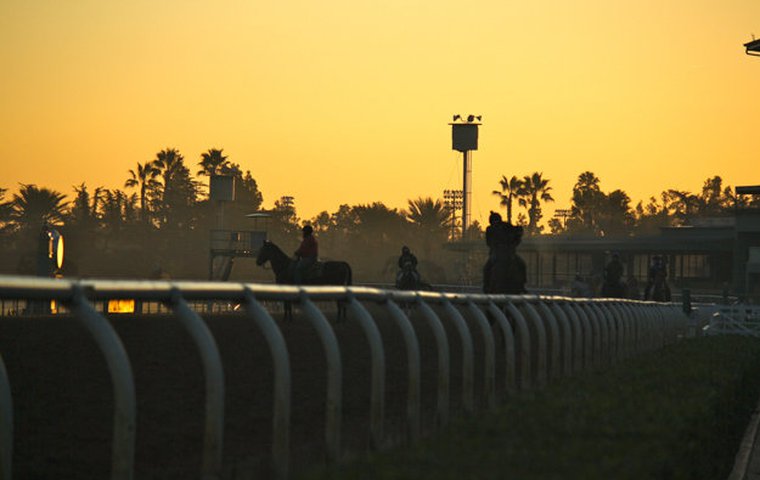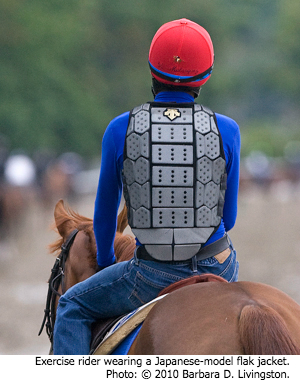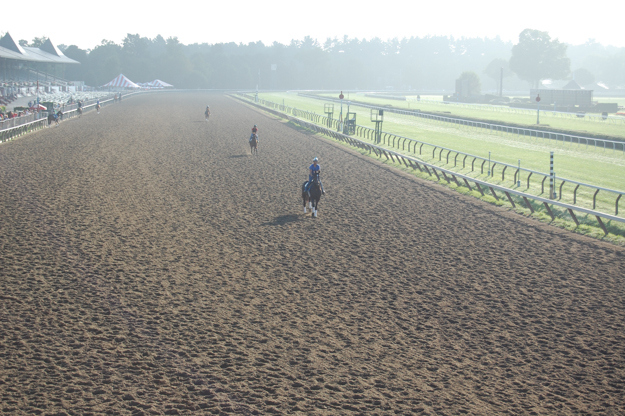
This week, our editorial content will focus on riders around the world. From profile stories to pieces addressing some of the issues riders face in the morning, the afternoon, and at the conclusion of their careers, we will take a closer look at the human athletes so central to our sport.
Thursday May 15, 2008 was the last day that Twei Lian-Reavey spent pain free.
The following morning, as dawn unfurled over Santa Anita Racetrack, a horse she had just pushed into a canter stood on a shoe and took a somersault, throwing her to the dirt. Stunned, sore, Lian-Reavey crawled off the track on her hands and knees and ambled slowly back to the barn, impatiently brushing off the attention of on-track paramedics. While unable to ride her remaining horses that morning, she made it to work the next day, and the next.
The following Monday though, when still in some discomfort, X-rays revealed that she had suffered multiple fractures of the spine.
Undeterred, Lian-Reavey continued to ride – much needed convalescence would come after June 25 and another ragged fall when a spooky young colt she was riding started at a sudden noise.
Even this second tumble failed to keep Lian-Reavey - a former jockey - grounded for long. By August, she was back plying her trade in the morning when one final jarring accident at Del Mar all but sounded the death knell on her exercise-riding career.
Lian-Reavey’s agonizing trilogy of falls in 2008 has left her tortured with near constant discomfort. Her pain medications remain on the shelf - a fear of possible addiction drives her toward holistic treatments. And years later, doctors are now considering spinal fusion and disc replacement surgery.
“I cannot sit for more than a few minutes at a time,” Lian-Reavey, now 53, explained. “I cannot drive. I find that I can’t do a lot of the simple things that I used to love to do, like gardening and playing the piano. I cannot even participate in things like Thanksgiving dinner. I’m a shadow of my former self.”
Rather than a tragic though singular tale, Lian-Reavey’s is an all too common story among those whose job pits thrill and threat chin-to-chin. For the grim list of dangers for an exercise rider are infinite: a stirrup iron that comes loose during a workout; a saddle that slips; a rein that snaps; a time-bomb of a filly who rears over backwards; a glancing kick; a loose-reined stumble; a horse panicked, bolting blindly toward home. Infinite those dangers may be, but they still go largely unacknowledged beyond the insular confines of the racetrack of a morning.
The tragic deaths of exercise riders Juan Vazquez and Mourad Boudraa earlier this year did garner a certain degree of attention. But had the same awful fate befallen a prominent rider during the afternoon, it is almost certain that the response would have been more immediate and powerful: many minutes of silence would have been called, many more tears would have fallen, and most crucially, many more questions would have been asked.
So what exactly is being done to ensure the safety of those hardy souls whose seven-day-a-week job it is to steer the wayward and master the obdurate? And what happens to exercise riders after accidents occur? Despite being a profession comprising thousands -- current numbers show more than 1,700 licensed exercise riders in New York and California alone -- no centralized body with serious clout advocates on their behalves. A patchwork of different answers therefore exists, revealing a troubling lack of uniformity throughout the nation.
Ask Brad McKinzie, vice president of operations at the insurance firm Finish Line Self Insurance Group, where he would ply his trade if he were an exercise rider, and his answer is unequivocal.
“California has the gold standard when it comes to exercise rider safety standards,” McKinzie said. “And we’re focused on safety issues far more now than at any time that I have ever seen because the cost of injuries to exercise riders is astronomical.”
Finish Line provides insurance coverage to 99 percent of trainers in the state, he said. But California – along with Maryland, New York, and New Jersey – is one of only four racing jurisdictions that mandate workers compensation coverage for their exercise riders. Underpinning that rather lop-sided statistic is cost.
According to McKinzie, trainers and owners in California contribute approximately $17 million annually in premiums. This breaks down into a payment of $2.95 cents per horse per day. A trainer with a stable of 50 horses, therefore, pays $53,690 a year in insurance premiums alone. “It’s a definite advantage not to have to pay workers’ comp.’”
The cost of injuries sustained by exercise riders consumes the largest hunk of the $17 million pie. Of the roughly 290 claims per year in California—comprising both Thoroughbred and Quarter Horse industries—80 percent pertain to injuries where humans have been directly injured by horses, while 64 percent pertain to exercise rider injuries.
“Exercise riders are by far the biggest group of losses we have,” McKinzie said.
The issue of compensation gets muddier in racing states where coverage for exercise riders isn’t mandated. Whether an exercise rider receives financial support after they’ve been injured depends on whether they were listed on the trainer’s payroll, said John Unick, managing director of the Equine and Special Risk Division for insurance brokers Bolton & Company.
For those exercise riders not reported on the payroll, or those riders injured while riding for a trainer without insurance, litigation is often their only recourse, he said.
“Usually, based on the legal process, it’s the deeper pockets that the lawyers are going to go after,” Unick said. “So, they’d probably go after the racetrack first.”
According to Phil Hanrahan, CEO of the National Horsemen’s Benevolent and Protective Association, the matter can be whittled down to the intricacies of state law.
“If a rider is truly an independent contractor, the trainer would have no responsibility for their injury,” said Hanrahan, before throwing in the caveat: “But if the rider is written a check by the trainer for riding the horse, the question then becomes this: Under state law, is the exercise rider deemed an employee or an independent contractor?”
For racetracks looking to manage their risks, discounted insurance is available to those facilities accredited under the National Thoroughbred Racing Association’s (NTRA) Safety and Integrity Alliance as part of a partnership with Lockton Insurance Brokers, said the Alliance’s Executive Director Mike Ziegler.
The NTRA accreditation process requires annual inspections of a track’s facilities to determine whether they meet minimum safety standards in a number of criteria. Currently, 22 tracks representing more than 70 percent of North American pari-mutuel handle are fully accredited.
The scope of the inspections frequently overlaps areas related to exercise rider safety, such as checking for padded starting gates and ensuring that riders wear helmets and safety vests approved by the Association of Racing Commissioners International (ARCI). But a disparity still exists among accredited tracks as to the degree of safety measures taken, especially in the quality of emergency medical assistance offered to stricken riders.
Accredited tracks are expected to maintain an on-track ambulance during training hours, and should suspend training when the ambulance isn’t present. But while some ambulances are staffed by paramedics, others are staffed by lesser-trained emergency medical technicians (EMTs).
“The difference between an EMT and a paramedic is a pretty sizable amount of training,” Ziegler said. EMT courses are generally 120-150 hours in length, while paramedic courses can range between 1,200 to 1,800 hours. “In the morning, we still see some EMTs, and we would prefer to not see EMTs. So, when we file our report with a track, we let them know they need to work on getting at least one paramedic of a morning.”
Ziegler also admits that mandating ARCI-approved helmets and vests is only as effective as the system in place to police the rule – a job that generally falls to the outriders. “And the outriders sometimes don’t have the ability to see what vests are used because the vests are covered. So, you’ve got to take it one step further and find out what vendors are located on the track. And that’s easier said than done.” 
Cost is perhaps the primary reason why exercise riders may fail to avail themselves of the latest approved safety gear, said Terry Meyocks, national manager of the Jockey’s Guild. “You’ve got newer helmets that cost anywhere between $350-1,200. It’s tough for many of the jockeys to afford it, so what about the exercise riders?”
A few years ago, the California Thoroughbred Trainers pooled approximately $8,000 for exercise riders to dip into to help pay for new equipment. But that was a rare example of largesse. And what happens too frequently after a fall is that compromised equipment—helmets with cracks, safety vests with broken zippers—is re-used, the rider either unwilling or unable to stump-up the hundreds of dollars needed for a replacement.
“Our industry is so far behind other sports,” Meyocks said. “We’ve got a lot of rules but they’re not being enforced, and we’ve got to make sure that we do everything we can do to protect the riders and the horses. The problem is, our industry just doesn’t work together.”
Protective gear, however, isn’t a fail-safe measure to shield riders from injury - the ultimate protection falls to the rider’s own ability according to Blake Heap, a California-based trainer and former outrider.
“Don’t get me wrong, equipment and everything helps,” he said. “But it’s really down to the rider, quite honestly. Freak things can happen, of course. But the same [lesser] riders are always having problems, while the good riders who are good hands [in the saddle], they’re hardly ever in trouble.”
Certain trainers notorious for having difficult horses, Heap noted, exacerbate the problem. All of which point toward what he sees as an across the board decline in standards of horsemanship.
“I don’t think the standard of riders is what it used to be because people don’t grow up riding, hardly,” he said. “There aren’t the farms around for young riders to grow up in. You now have to learn your job at the racetrack, almost. And it’s too bad it’s that way.”
Heap’s is a frequently heard sentiment throughout the industry, and The Jockey Club Thoroughbred Safety Committee recently called for enhanced rules on continuing education for trainers. But amid the wider discussion of rider safety emerges a sometimes disparate chorus of voices, each offering their own take on how to resolve one central question: Is there a way of streamlining the many facets of exercise rider safety to make the job safer and the delegation of responsibility clearer? A handful of racetracks around the U.S. believe that they’ve found an answer.

As Hugh Gallagher drives through Belmont Park’s main gates of a winter-glazed morning, his eyes aren’t necessarily drawn to the frost-varnished skeletons of Oak and Maple, nor to the horses that pass by, their breaths billowing before them in clouds of swirling silver, but rather to those atop the fire breathers, swaddled Eskimo-like against the frigid cold.
“The very first thing I do, even before I park, is look for helmet chin-straps that are securely fastened, not just hanging three-inches down from the chin,” he said.
Gallagher – appointed in May as The New York Racing Association’s (NYRA) first safety steward – has primary responsibility for equine and human safety at Aqueduct Racetrack, Belmont Park, and Saratoga Race Course. He admits that his school-masterly approach sometimes grates with the riders.
“There are some people who are set in their ways, and they don’t care for it so much,” Gallagher said. “But in the regulatory world and in the world of stewards, everything’s equal to all. So, if we do it for one person whether it’s an exercise rider or a Hall of Fame trainer, it’s got to be equally applied to all or it’s not worth it.”
But double-checking that helmets are properly fastened and vests are zipped-up is only one segment of the puzzle. Gallagher, for example, has become a familiar face around the starting gates and schooling paddock of a morning, and he’s seen around the barns more frequently as part of NYRA’s ramped up regime of inspections and searches.
Safety stewards are a rare breed, however – most racing jurisdictions don’t employ them, and it was a mere eight years ago that the very idea of a safety steward was first conceived.
“In 2006, [former California Horse Racing Board executive director] Kirk Breed said that he wanted to assign someone to focus specifically on the safety of the horse and the riders,” said California Safety Steward Luis Jauregui. “People don’t realize just how far ahead of the game California is in terms of racetrack safety.”
Having been a jockey and exercise rider, Jauregui “sees things that other people don’t see” - possible dangers the equine-illiterate can too easily overlook.
Some of the things he has already seen and changed are more cosmetic dangers that require only cosmetic surgery. One such is a system whereby the location of loose horses is broadcast for all to hear over a loud-speaker.
But some changes have required a more nuanced understanding of the forces at play, including a relatively recent mandate to ensure that riders taking flight around the track for the first time have the necessary smarts for the job.
“It’s called a provisional exercise rider license, and I think it’s a great thing that other jurisdictions should have,” he said.
Because the farms where in the past young riders first learned to ride racehorses have largely vanished, fresh recruits to the racetrack riding ranks are less polished than they once were, Juaregui noted, echoing Blake Heap’s remarks.
To compensate, new riders in California now have to prove their mettle under the stewardship of a single trainer before being granted a full exercise rider’s license. “They can only get on a certain amount of horses…It’s a fallback to the old-school giving trainers the opportunity to assess a rider’s ability, making them more responsible.”
Inexperienced riders aren’t the only factors shaping the safety debate in California. Hollywood Park’s closure last year siphoned hundreds of horses toward the remaining tracks, stretching their capacity. More horses means less space on the track of a morning, and less space means greater possibility for mishap. When Fairplex closes, the situation is expected to worsen.
Juaregui, though, has one solution – extend training hours to dilute the number of horses on the track at one time.
“Probably the safest thing for everybody would be to have longer training times,” he said, conceding that the first post time might have to be pushed back as a result. “It’s so important to allow horses to take their time, to slow things down so they’re not wound up.”
Perhaps the greatest impediment to the likes of Juaregui and Gallagher becoming a more ubiquitous presence around the nation is that they don’t come cheap, and their recommendations rarely ever so. Which is why other states with shallower pockets have to be a little more imaginative in their approach to the issue of safety, said Marc Laino, executive director of the Illinois Racing Board.
“As resources among racing jurisdictions continue to decline, we need to be much more creative as far as staffing, restructuring, and reclassifying positions in order to become a little more efficient,” Laino said. “That being said, we do like the concept of the safety steward.”
Responsibilities are delegated around a variety of parties at Illinois racetracks, he said. Trainers are largely answerable for their riders wearing the correct equipment, for example, whereas the existing panel of stewards in Illinois oversees a broad swath of issues relating to equine, track, and rider safety. “Overall, there’s shared responsibility between the Racing Board and the racetracks themselves.”
Some tracks are proving ahead of the game in terms of modifying their facilities – such as Del Mar, where the Fontana Rail that circled the old turf course has been replaced with a Mawsafe Running Rail - the first in the country. But the fight for innovation and improvement at racetracks is arriving at a time when many injured riders are fighting their own desperate, more personal battles.
Returning to the story of Twei Lian-Reavey, the rider injured in 2008 says she has endured years of torrid wranglings over workers’ compensation coverage.
Injured when many trainers in California were still covered by the insurance firm AIG, Lian-Reavey said that her loss of earnings payments were cut two years after the accident—she subsequently had to take in lodgers in order to stay afloat financially—and admits to butting heads with AIG as to what treatment she should be receiving.
But despite the awful physical and psychological toll of the last six or so years, Lian-Reavey still harbors dreams of returning to the job she loves.
“That is my plan. As soon as they patch me up, I’ll be back on a horse,” she said, betraying a curious characteristic of exercise riders that can be deemed both a virtue and a failing: a stubborn unwillingness to let injury and impediment keep them from the saddle.
“When we stop riding, we fall into this great depression more than any other occupation I can think of. A lot of people may think I’m being unwise and foolish to want to ride again, but riders understand that that’s what we do – we keep going. It’s part of our make-up. Riding, it’s…” she said, pausing for a brief moment. “Riding is our life.”
---
Daniel Ross is a Los Angeles-based freelance writer who has worked as an exercise rider in the U.S. and abroad.


